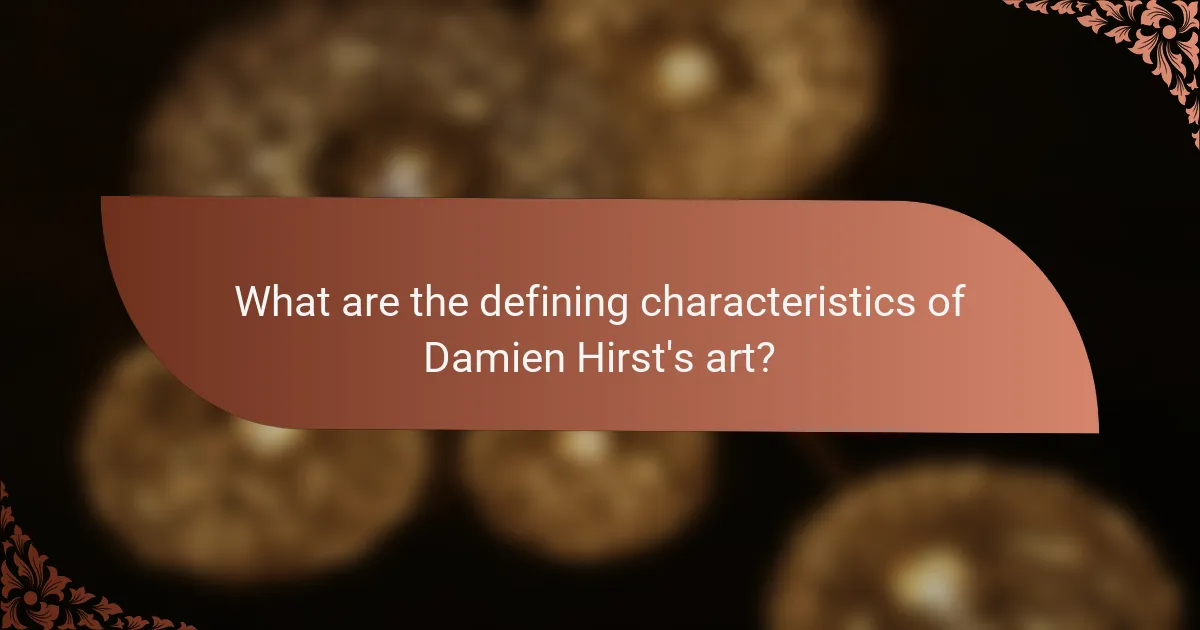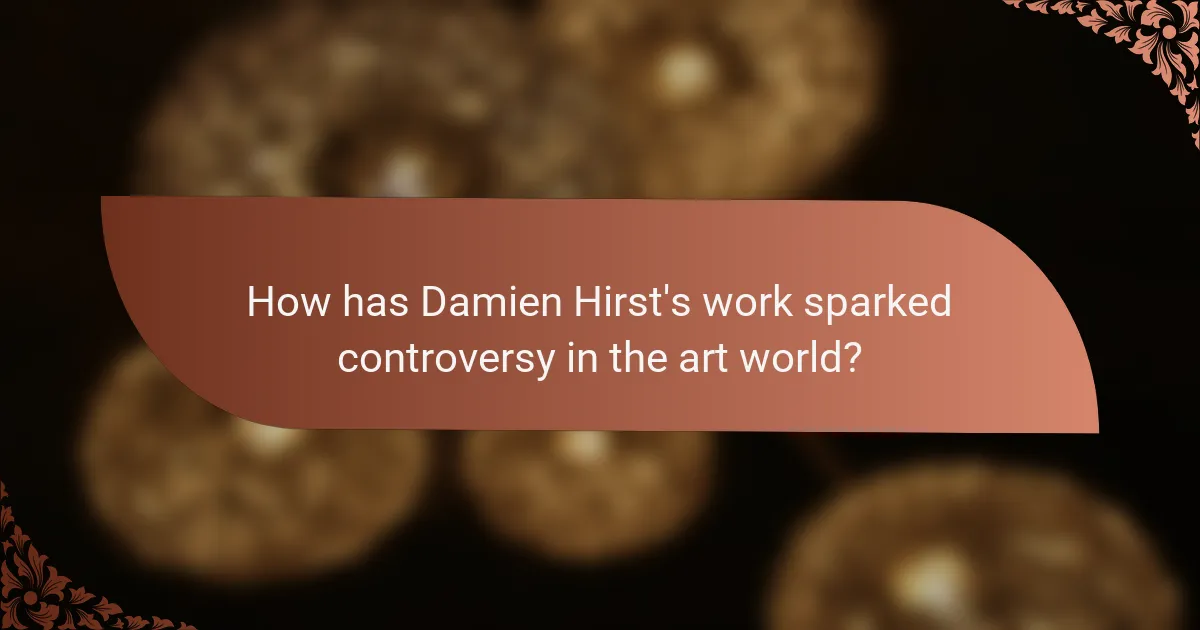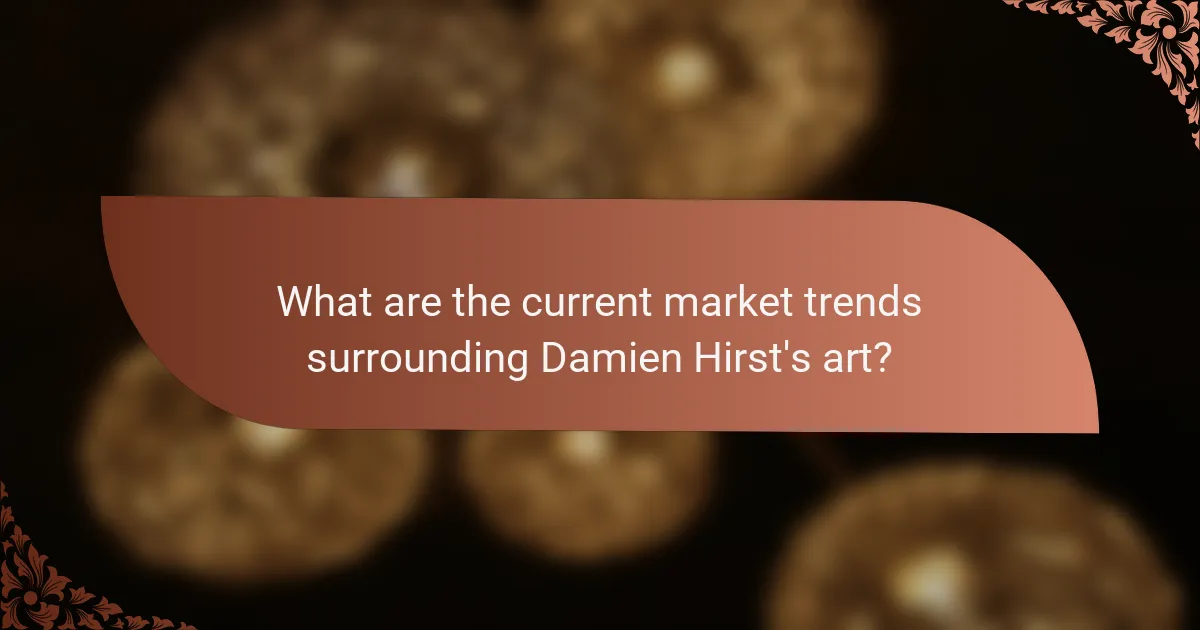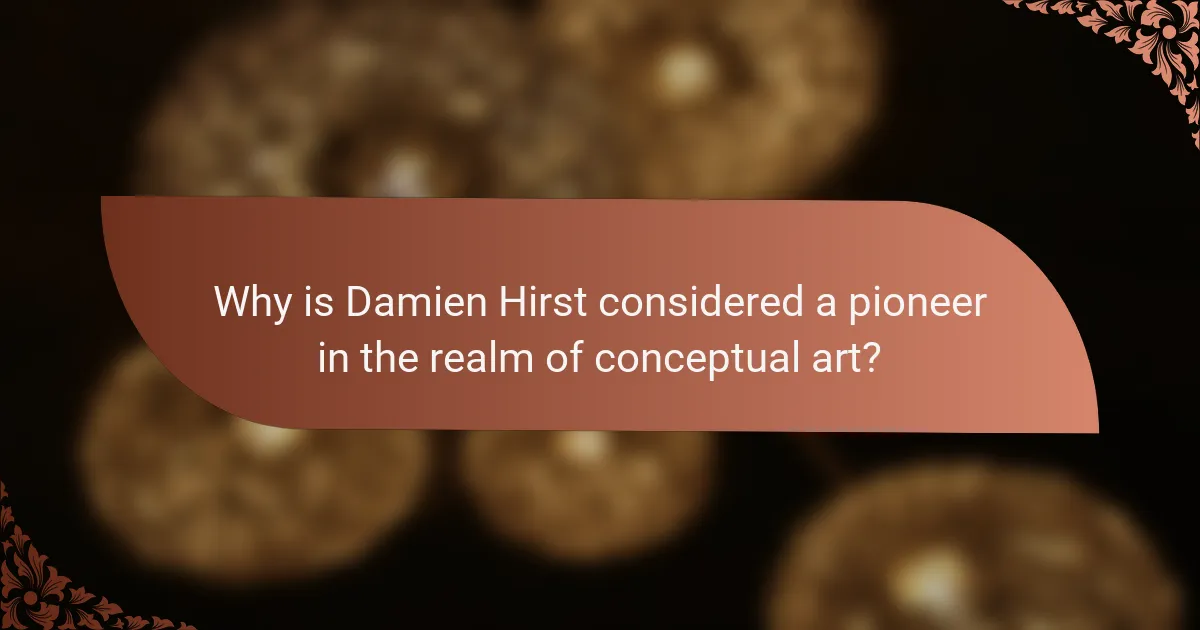Damien Hirst’s provocative art challenges traditional boundaries and raises questions about life, death, and commercialism. This article explores his controversial works, significant market trends, and the impact of conceptual art. Hirst’s unique use of materials, such as preserved animals, and his record-breaking auction sales illustrate his influence in contemporary art. Additionally, the rise of digital art and NFTs reflects his evolving market strategies.

What are the defining characteristics of Damien Hirst’s art?
Damien Hirst’s art is characterized by its conceptual depth, use of unconventional materials, and exploration of mortality. His works often provoke controversy and challenge traditional artistic boundaries. Hirst employs unique attributes like the use of preserved animals and pharmaceutical themes, exemplified in pieces such as “The Physical Impossibility of Death in the Mind of Someone Living.” His market trends reflect significant auction results, showcasing the high value and demand for his art.
How does Hirst’s use of materials influence his artistic expression?
Hirst’s use of materials significantly shapes his artistic expression by challenging traditional boundaries. His choice of unconventional materials, such as formaldehyde and surgical instruments, evokes themes of life, death, and consumerism. This unique attribute creates a visceral experience that engages viewers on multiple levels. For example, the use of preserved animals in his works confronts the audience with mortality, prompting reflection on the fragility of existence. Additionally, Hirst’s incorporation of spot paintings and pill sculptures reflects a commentary on the commodification of art, merging aesthetics with market trends.
What themes are prevalent in Hirst’s works?
Damien Hirst’s works often explore themes of mortality, the nature of art, and the relationship between life and death. His use of unconventional materials, such as preserved animals, challenges traditional artistic boundaries. Hirst frequently addresses the concept of value, both in the art market and in life itself, making his pieces provocative and thought-provoking. Additionally, themes of consumerism and the fleeting nature of existence are prevalent, reflecting cultural anxieties.

How has Damien Hirst’s work sparked controversy in the art world?
Damien Hirst’s work has sparked controversy by challenging traditional art values and ethics. His use of unconventional materials, such as dead animals preserved in formaldehyde, questions the boundaries of art. Hirst’s pieces, like “The Physical Impossibility of Death in the Mind of Someone Living,” provoke discussions about life, death, and commercialism in art. Critics argue that his work prioritizes shock value over artistic integrity, while supporters praise his innovation and conceptual depth. The market trends surrounding his art reflect this divide, with high auction prices highlighting both demand and ongoing debate about the nature of contemporary art.
Which specific pieces have been the most controversial?
Damien Hirst’s most controversial pieces include “The Physical Impossibility of Death in the Mind of Someone Living,” “For the Love of God,” and “The Golden Calf.” These works sparked debates over ethics, value, and the nature of art. Hirst’s use of real animal specimens and expensive materials challenged traditional art norms, making his work polarizing. The reactions to these pieces highlight the ongoing tension between conceptual art and audience acceptance.
What reactions have emerged from critics and audiences regarding Hirst’s controversial works?
Critics and audiences have expressed mixed reactions to Damien Hirst’s controversial works. While some praise his innovative approach to conceptual art, others criticize his reliance on shock value.
Critics often highlight the commercialism of Hirst’s art, arguing it undermines artistic integrity. For instance, the high prices of his pieces, such as “The Physical Impossibility of Death in the Mind of Someone Living,” spark debates on the value of art.
Conversely, audiences are captivated by the boldness and originality of his creations. Many appreciate how Hirst challenges traditional notions of art, leading to a broader acceptance of diverse artistic expressions.
Overall, Hirst’s work continues to provoke dialogue, reflecting the evolving landscape of contemporary art.

What are the current market trends surrounding Damien Hirst’s art?
Damien Hirst’s art market trends indicate a growing interest in his conceptual works, with auction prices fluctuating significantly. Recent sales show pieces fetching millions, reflecting both collector demand and market speculation. Unique attributes, such as his use of unconventional materials, continue to attract attention. Additionally, the rise of digital art and NFTs has influenced Hirst’s market strategy, diversifying his portfolio. As a result, Hirst remains a pivotal figure in contemporary art, embodying both controversy and commercial success.
How do auction results reflect the value of Hirst’s works?
Auction results significantly indicate the market value of Damien Hirst’s works. High sale prices reflect both the artist’s popularity and the demand for contemporary art. For instance, Hirst’s piece “The Physical Impossibility of Death in the Mind of Someone Living” sold for $8 million, showcasing its perceived value. Additionally, auction trends often reveal shifts in collector interest, influencing future valuations. The fluctuating prices of Hirst’s works can also be attributed to his unique approach to conceptual art, which often challenges traditional boundaries and attracts diverse buyers.
What factors contribute to the fluctuating demand for Hirst’s pieces?
The demand for Damien Hirst’s pieces fluctuates due to market trends, critical reception, and collector interest. Economic factors affect buyers’ purchasing power, while the evolving perception of conceptual art influences desirability. Hirst’s unique attributes, such as provocative themes and innovative techniques, also play a significant role. As a result, shifts in cultural trends and art market dynamics can lead to significant changes in demand for his works.

Which unique attributes distinguish Damien Hirst from other contemporary artists?
Damien Hirst is distinguished by his unique blend of controversial themes, innovative use of materials, and market influence. His works often challenge perceptions of life and death, exemplified by pieces like “The Physical Impossibility of Death in the Mind of Someone Living.” Hirst’s incorporation of unconventional materials, such as formaldehyde and live animals, sets him apart from his contemporaries. Additionally, his ability to create significant market trends, including record-breaking auction sales, highlights his unique position in the contemporary art scene.
How does Hirst’s approach to conceptual art differ from traditional methods?
Hirst’s approach to conceptual art emphasizes idea over traditional craftsmanship. He challenges norms by utilizing unconventional materials and methods, often provoking strong reactions. Unlike traditional artists, Hirst focuses on the concept behind the work, making the viewer question the nature of art itself. His unique attribute is the integration of commercialism, as he navigates the art market with strategic marketing techniques.
What role does the concept of death play in his artistic narrative?
The concept of death plays a central role in Damien Hirst’s artistic narrative, symbolizing both the fragility of life and the inevitability of mortality. His works, such as “The Physical Impossibility of Death in the Mind of Someone Living,” confront viewers with stark representations of death, prompting reflection on existence. Hirst’s unique approach often intertwines themes of life and death, creating a dialogue about human experience. This focus on mortality not only drives his artistic vision but also influences market trends, as collectors seek pieces that challenge conventional perceptions of art and life.

Why is Damien Hirst considered a pioneer in the realm of conceptual art?
Damien Hirst is considered a pioneer in conceptual art due to his innovative approaches and provocative works. His use of unconventional materials, such as preserved animals and pharmaceuticals, challenges traditional artistic boundaries. Hirst’s iconic piece, “The Physical Impossibility of Death in the Mind of Someone Living,” exemplifies his unique attribute of merging art with existential themes. Additionally, his marketing strategies and the commercial success of his works have significantly influenced market trends in contemporary art. As a result, Hirst has redefined the role of the artist in the art market, making him a pivotal figure in the evolution of conceptual art.
How has Hirst influenced the perception of art as a commodity?
Damien Hirst has significantly shaped the perception of art as a commodity by merging artistic expression with market dynamics. His works, such as “The Physical Impossibility of Death in the Mind of Someone Living,” exemplify this shift, positioning art as a high-value investment. Hirst’s unique approach challenges traditional views, emphasizing scarcity and branding in art. As a result, he has influenced market trends, leading to art being treated more like a financial asset rather than solely a cultural artifact. This transformation has sparked debates about the authenticity and value of art in contemporary society.
Which art movements align with Hirst’s conceptual approach?
Damien Hirst’s conceptual approach aligns with movements such as Dadaism, Surrealism, and Postmodernism. Dadaism challenges traditional aesthetics, paralleling Hirst’s provocative pieces. Surrealism’s exploration of the unconscious resonates with his themes of life and death. Postmodernism’s questioning of originality reflects in Hirst’s use of ready-made objects and commercial techniques. These movements collectively underscore Hirst’s engagement with concepts beyond mere visual representation.

What are the implications of Hirst’s artistic practices on the future of contemporary art?
Hirst’s artistic practices significantly influence the future of contemporary art by challenging traditional boundaries and market perceptions. His use of unconventional materials and themes encourages artists to explore new mediums and concepts. As a result, the art market increasingly values originality and conceptual depth. Hirst’s works, often polarizing, prompt discussions on the nature of art and its societal role. This ongoing dialogue shapes emerging trends, pushing artists to innovate and redefine artistic expression.
How can artists learn from Hirst’s business strategies?
Artists can learn from Hirst’s business strategies by embracing innovation, engaging with the market, and leveraging controversy. Hirst’s approach includes creating limited editions, which enhances exclusivity and demand. He effectively uses social media to connect with audiences, promoting his work and brand. Additionally, his willingness to challenge traditional art norms invites dialogue and attracts attention, demonstrating the power of conceptual art in driving market trends. Artists can apply these strategies to build their own unique identities and optimize their market presence.
What are the common pitfalls to avoid when engaging with conceptual art?
Engaging with conceptual art can lead to misunderstandings and missed opportunities. Common pitfalls include overemphasis on aesthetics, neglecting the artist’s intent, and dismissing the context of the work. Additionally, failing to engage with the narrative behind pieces, such as Damien Hirst’s controversial works, can limit appreciation. Lastly, avoiding critical discussions or debates around conceptual art may hinder deeper understanding and connection.
